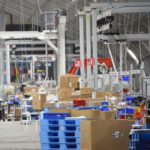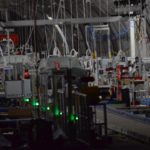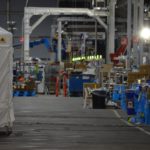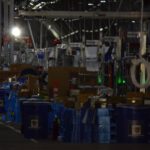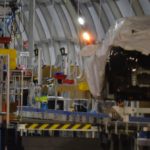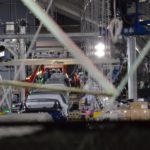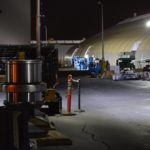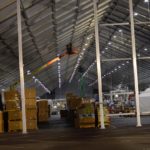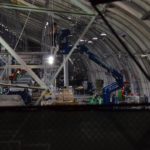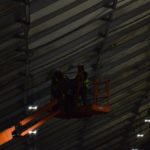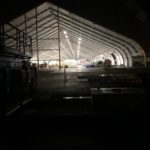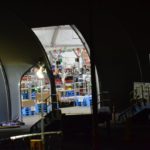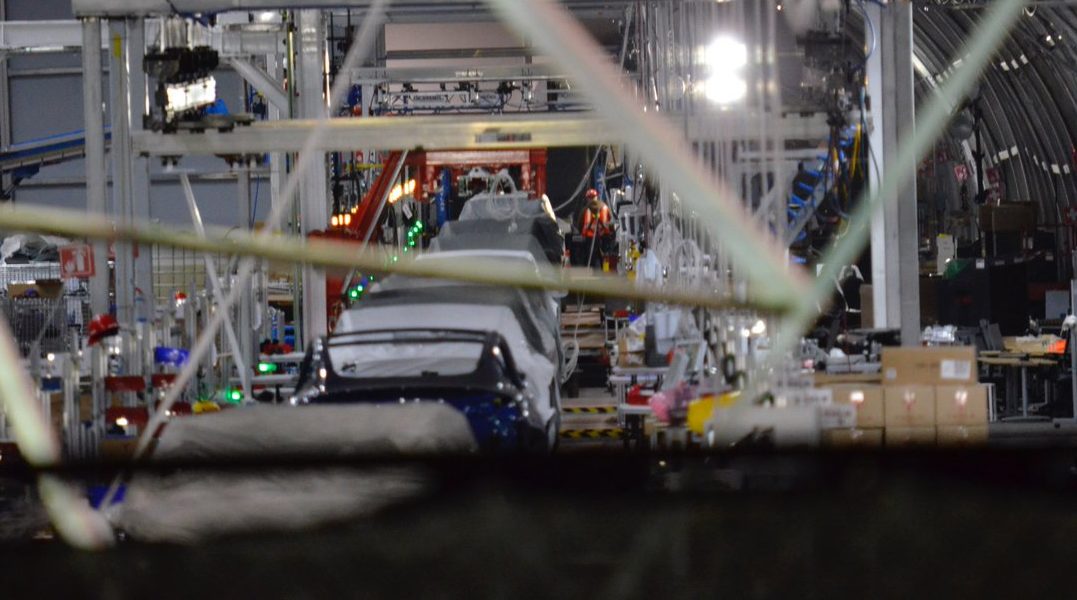
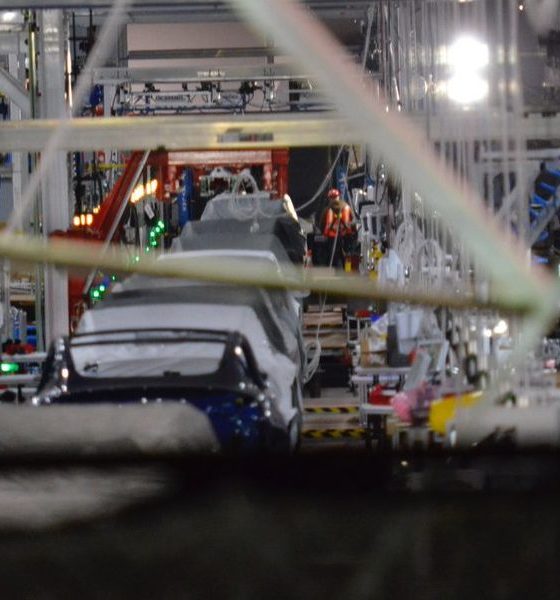
News
Spy shots inside Tesla’s giant tent suggest assembly line buildout in progress
Spy shots taken of Tesla’s giant tent at Fremont show that the buildout of the company’s new Model 3 assembly line is still ongoing. As could be seen in images showcasing the new structure, the giant tent still has a lot of open room despite machinery already in place.
The spy shots were uploaded and shared on Twitter by @skabooshka, who noted that the assembly line did not appear to be moving when he took photographs of the structure’s interior. He did note, however, that there was work still being done on the tent itself, as evidenced by a crane and employees in safety gear working at the roof of the structure.
- The interior of Tesla’s massive tent on the grounds of the Fremont Factory. [Credit: skabooshka/Twitter]
- The interior of Tesla’s massive tent on the grounds of the Fremont Factory. [Credit: skabooshka/Twitter]
- The interior of Tesla’s massive tent on the grounds of the Fremont Factory. [Credit: skabooshka/Twitter]
- The interior of Tesla’s massive tent on the grounds of the Fremont Factory. [Credit: skabooshka/Twitter]
- The interior of Tesla’s massive tent on the grounds of the Fremont Factory. [Credit: skabooshka/Twitter]
- The interior of Tesla’s massive tent on the grounds of the Fremont Factory. [Credit: skabooshka/Twitter]
Apart from spy shots, a number of videos featuring the giant tent and Tesla’s new Model 3 assembly line were also uploaded on Twitter, courtesy of @IspyTsla, who was able to capture more than 2 minutes of activity inside and around the structure. The footage taken of Tesla’s giant tent could be viewed below.
— IspyTSLA (@IspyTsla) June 19, 2018
Overall, the new spy shots and spy video of Tesla’s new Fremont structure suggests that Tesla is still working on completing its new assembly line. Considering the open space still available inside the tent, it appears that Tesla will be adopting Elon Musk’s idea of avoiding over-automation with the production of the Model 3.
Tesla CEO Elon Musk has shown a particularly high level of optimism about the potential of the new tent-based Model 3 line. In a series of tweets, Musk stated that Tesla built a giant tent because constructing another building to house the machinery within the company’s target timeline would be impossible. According to Musk, the Tesla team was able to set up the massive structure in just two weeks, which was practically “miraculous.”
- The interior of Tesla’s massive tent on the grounds of the Fremont Factory. [Credit: skabooshka/Twitter]
- The interior of Tesla’s massive tent on the grounds of the Fremont Factory. [Credit: skabooshka/Twitter]
- The interior of Tesla’s massive tent on the grounds of the Fremont Factory. [Credit: skabooshka/Twitter]
- The interior of Tesla’s massive tent on the grounds of the Fremont Factory. [Credit: skabooshka/Twitter]
- The interior of Tesla’s massive tent on the grounds of the Fremont Factory. [Credit: skabooshka/Twitter]
- The interior of Tesla’s massive tent on the grounds of the Fremont Factory. [Credit: skabooshka/Twitter]
The interior of Tesla’s massive tent on the grounds of the Fremont factory. [Credit: skabooshka/Twitter]
As noted in an Ars Technica report, a January 2018 geotechnical investigation report on file with the city building permit office states that Tesla has plans to construct a 500,000 square-foot “multi-story building north of the existing North Paint Building.” With this in mind, Tesla’s massive tent in Fremont might very well be a temporary solution designed to boost the company’s production capabilities of the Model 3 to help the company achieve profitability by Q3 and Q4 2018. As for the giant tent itself, journalist Edward Niedermeyer has revealed that Tesla’s permits for the structure are currently valid for “up to six months.”
With the end of Q2 2018 only a little more than a week away, Tesla is on a rush to attain its target of producing 5,000 Model 3 per week before the end of the quarter. The goal, which has eluded Tesla since the compact electric car started production, is closer than ever before. Considering that Elon Musk revealed that the company was producing the Model 3 at a rate of 500 vehicles per day during the 2018 Annual Shareholder Meeting, the addition of the new tent-based assembly line could very well be the deciding factor whether Tesla could finally achieve its Model 3 production targets or come up short once more.

News
Tesla starts showing how FSD will change lives in Europe
Local officials tested the system on narrow country roads and were impressed by FSD’s smooth, human-like driving, with some calling the service a game-changer for everyday life in areas that are far from urban centers.

Tesla has launched Europe’s first public shuttle service using Full Self-Driving (Supervised) in the rural Eifelkreis Bitburg-Prüm region of Germany, demonstrating how the technology can restore independence and mobility for people who struggle with limited transport options.
Local officials tested the system on narrow country roads and were impressed by FSD’s smooth, human-like driving, with some calling the service a game-changer for everyday life in areas that are far from urban centers.
Officials see real impact on rural residents
Arzfeld Mayor Johannes Kuhl and District Administrator Andreas Kruppert personally tested the Tesla shuttle service. This allowed them to see just how well FSD navigated winding lanes and rural roads confidently. Kruppert said, “Autonomous driving sounds like science fiction to many, but we simply see here that it works totally well in rural regions too.” Kuhl, for his part, also noted that FSD “feels like a very experienced driver.”
The pilot complements the area’s “Citizen Bus” program, which provides on-demand rides for elderly residents who can no longer drive themselves. Tesla Europe shared a video of a demonstration of the service, highlighting how FSD gives people their freedom back, even in places where public transport is not as prevalent.
What the Ministry for Economic Affairs and Transport says
Rhineland-Palatinate’s Minister Daniela Schmitt supported the project, praising the collaboration that made this “first of its kind in Europe” possible. As per the ministry, the rural rollout for the service shows FSD’s potential beyond major cities, and it delivers tangible benefits like grocery runs, doctor visits, and social connections for isolated residents.
“Reliable and flexible mobility is especially vital in rural areas. With the launch of a shuttle service using self-driving vehicles (FSD supervised) by Tesla in the Eifelkreis Bitburg-Prüm, an innovative pilot project is now getting underway that complements local community bus services. It is the first project of its kind in Europe.
“The result is a real gain for rural mobility: greater accessibility, more flexibility and tangible benefits for everyday life. A strong signal for innovation, cooperation and future-oriented mobility beyond urban centers,” the ministry wrote in a LinkedIn post.
News
Tesla China quietly posts Robotaxi-related job listing
Tesla China is currently seeking a Low Voltage Electrical Engineer to work on circuit board design for the company’s autonomous vehicles.

Tesla has posted a new job listing in Shanghai explicitly tied to its Robotaxi program, fueling speculation that the company is preparing to launch its dedicated autonomous ride-hailing service in China.
As noted in the listing, Tesla China is currently seeking a Low Voltage Electrical Engineer to work on circuit board design for the company’s autonomous vehicles.
Robotaxi-specific role
The listing, which was shared on social media platform X by industry watcher @tslaming, suggested that Tesla China is looking to fill the role urgently. The job listing itself specifically mentions that the person hired for the role will be working on the Low Voltage Hardware team, which would design the circuit boards that would serve as the nervous system of the Robotaxi.
Key tasks for the role, as indicated in the job listing, include collaboration with PCB layout, firmware, mechanical, program management, and validation teams, among other responsibilities. The role is based in Shanghai.
China Robotaxi launch
China represents a massive potential market for robotaxis, with its dense urban centers and supportive policies in select cities. Tesla has limited permission to roll out FSD in the country, though despite this, its vehicles have been hailed as among the best in the market when it comes to autonomous features. So far, at least, it appears that China supports Tesla’s FSD and Robotaxi rollout.
This was hinted at in November, when Tesla brought the Cybercab to the 8th China International Import Expo (CIIE) in Shanghai, marking the first time that the autonomous two-seater was brought to the Asia-Pacific region. The vehicle, despite not having a release date in China, received a significant amount of interest among the event’s attendees.
Elon Musk
Elon Musk and Tesla AI Director share insights after empty driver seat Robotaxi rides
The executives’ unoccupied tests hint at the rapid progress of Tesla’s unsupervised Robotaxi efforts.

Tesla CEO Elon Musk and AI Director Ashok Elluswamy celebrated Christmas Eve by sharing personal experiences with Robotaxi vehicles that had no safety monitor or occupant in the driver’s seat. Musk described the system’s “perfect driving” around Austin, while Elluswamy posted video from the back seat, calling it “an amazing experience.”
The executives’ unoccupied tests hint at the rapid progress of Tesla’s unsupervised Robotaxi efforts.
Elon and Ashok’s firsthand Robotaxi insights
Prior to Musk and the Tesla AI Director’s posts, sightings of unmanned Teslas navigating public roads were widely shared on social media. One such vehicle was spotted in Austin, Texas, which Elon Musk acknowleged by stating that “Testing is underway with no occupants in the car.”
Based on his Christmas Eve post, Musk seemed to have tested an unmanned Tesla himself. “A Tesla with no safety monitor in the car and me sitting in the passenger seat took me all around Austin on Sunday with perfect driving,” Musk wrote in his post.
Elluswamy responded with a 2-minute video showing himself in the rear of an unmanned Tesla. The video featured the vehicle’s empty front seats, as well as its smooth handling through real-world traffic. He captioned his video with the words, “It’s an amazing experience!”
Towards Unsupervised operations
During an xAI Hackathon earlier this month, Elon Musk mentioned that Tesla owed be removing Safety Monitors from its Robotaxis in Austin in just three weeks. “Unsupervised is pretty much solved at this point. So there will be Tesla Robotaxis operating in Austin with no one in them. Not even anyone in the passenger seat in about three weeks,” he said. Musk echoed similar estimates at the 2025 Annual Shareholder Meeting and the Q3 2025 earnings call.
Considering the insights that were posted Musk and Elluswamy, it does appear that Tesla is working hard towards operating its Robotaxis with no safety monitors. This is quite impressive considering that the service was launched just earlier this year.
